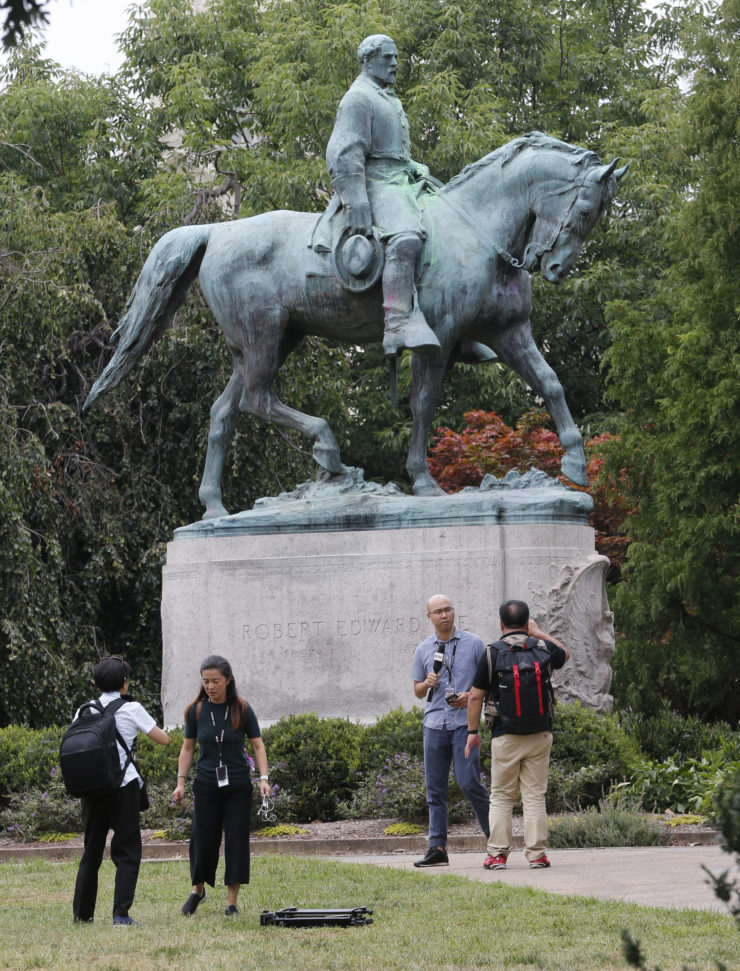An “AP Explains” piece illustrates just how difficult it is to get racial nuance right in the Trump era, even when journalists set out to bring much needed context to maybe the most vexing issue we face. The first clue that the piece got it wrong was in the headline, which read: “How Robert E. Lee went from hero to racist icon.”
The headline accurately explains the story, which is why those involved should have immediately asked themselves a simple question: When was Lee a hero, and to whom? Even a cursory knowledge of Southern history would have told them he was only ever a hero to white Southerners, or more specifically, white Southerners who have romanticized the Confederacy.
Some have romanticized the “lost cause” because it was a way to downplay the devastating defeat our region suffered during the Civil War. Others have done so because it gives them a way to revere ancestors who fought for the South. Others still have simply been caught unaware by a century-long effort to re-imagine why the South went to war through popular TV shows, such as “The Dukes of Hazzard,” whose primary star was an orange car, topped with a Confederate flag and named after Lee, and through history books written by Confederate sympathizers that were adopted by numerous public schools throughout the South. In those books, abolitionists were treated like unwelcome antagonists.
Lee was—and is—a hero to those white Southerners, even the ones who agreed to bring down the Confederate flag, after a half century of flying at the South Carolina Statehouse, after a white supremacist murdered nine black people in a Charleston church. Lee was never a hero to black Southerners and Native American Southerners. He was always a racist icon.
In much of the reporting on fraught issues of race in the South, journalists have tended to be so even-handed as to distort history. Which is why, if you look through the archives of just about any newspaper or local news station, you’ll find headlines that have some form of the “heritage vs. hate” format on reports about Confederate flag protests. On the one hand, you have Confederate supporters arguing they want the flag to fly in public spaces on the public’s dime because of heritage. On the other, you have black and Native American Southerners saying it shouldn’t be. It’s a neat, clean way of distilling down a still not-well-understood period of our history—when highlighting mess and contradiction is the only way to help readers, listeners, and viewers get closer to the truth.
The “How Robert E. Lee went from hero to racist icon” analysis provides important historical context about how Lee, who experts view as one of the country’s most inept wartime generals, came to be viewed as one of America’s most daring generals ever – by the white Southerners who revere the Confederacy. Lee, a man whose military treated blacks harshly and who did awful things to his own black slaves, has been turned into a God-fearing, virtuous man who called for peace and equality—by the white Southerners who revere the Confederacy.
The AP wrote: “His transformation, at the center of the recent violence in Charlottesville, Virginia, reflects the changing moods in the United States around race, mythology and national reconciliation, historians say. Lee monuments, memorials and schools in his name erected at the turn of the 20th Century are now facing scrutiny amid a demographically changing nation.”
That sounds eerily like the thinking of a member of the South Carolina General Assembly who, after calls for the Confederate flag to be removed grew louder after Dylann Roof killed black people during a Bible study, said he was surprised because the flag had not been an issue in the years leading up to that event. He was right that it wasn’t an issue to most white Southerners. He was wrong—egregiously wrong—that it hadn’t been an issue for black and Native American Southerners. The flag never stopped being an issue for them.
It became an issue when former Confederate soldiers after the Civil War founded the Ku Klux Klan, and that domestic terror group murdered and raped and lynched and intimidated black and Native American Southerners in a variety of other ways throughout the 20th century. There were moments when protests against the flag were louder than others, and the years before the Roof shooting were among the quieter moments. But it wasn’t because the flag had stopped being an issue, just that it’s hard to keep screaming while those in power keep ignoring your cries. The issue didn’t change; it’s just that once-ignored voices are now being heard in a browning America.
Here’s the thrust of what happened in Virginia this past week: Black and Native American Southerners have for decades found a way to live with the veneration of the Confederacy—a short-lived nation built upon the belief that blacks were inferior and should forever be in bondage – including having their tax money and open spaces used for monuments to those who hated them.
Young white supremacists couldn’t handle the removal of one of those monuments without a violent response. Their entitlement was molded by a distorted view of Southern history that long relegated black and Native American views to secondary status, if not outright irrelevance. Journalists should be careful not to inadvertently continue that legacy.
The headline accurately explains the story, which is why those involved should have immediately asked themselves a simple question: When was Lee a hero, and to whom? Even a cursory knowledge of Southern history would have told them he was only ever a hero to white Southerners, or more specifically, white Southerners who have romanticized the Confederacy.
Some have romanticized the “lost cause” because it was a way to downplay the devastating defeat our region suffered during the Civil War. Others have done so because it gives them a way to revere ancestors who fought for the South. Others still have simply been caught unaware by a century-long effort to re-imagine why the South went to war through popular TV shows, such as “The Dukes of Hazzard,” whose primary star was an orange car, topped with a Confederate flag and named after Lee, and through history books written by Confederate sympathizers that were adopted by numerous public schools throughout the South. In those books, abolitionists were treated like unwelcome antagonists.
Lee was—and is—a hero to those white Southerners, even the ones who agreed to bring down the Confederate flag, after a half century of flying at the South Carolina Statehouse, after a white supremacist murdered nine black people in a Charleston church. Lee was never a hero to black Southerners and Native American Southerners. He was always a racist icon.
In much of the reporting on fraught issues of race in the South, journalists have tended to be so even-handed as to distort history. Which is why, if you look through the archives of just about any newspaper or local news station, you’ll find headlines that have some form of the “heritage vs. hate” format on reports about Confederate flag protests. On the one hand, you have Confederate supporters arguing they want the flag to fly in public spaces on the public’s dime because of heritage. On the other, you have black and Native American Southerners saying it shouldn’t be. It’s a neat, clean way of distilling down a still not-well-understood period of our history—when highlighting mess and contradiction is the only way to help readers, listeners, and viewers get closer to the truth.
The “How Robert E. Lee went from hero to racist icon” analysis provides important historical context about how Lee, who experts view as one of the country’s most inept wartime generals, came to be viewed as one of America’s most daring generals ever – by the white Southerners who revere the Confederacy. Lee, a man whose military treated blacks harshly and who did awful things to his own black slaves, has been turned into a God-fearing, virtuous man who called for peace and equality—by the white Southerners who revere the Confederacy.
The AP wrote: “His transformation, at the center of the recent violence in Charlottesville, Virginia, reflects the changing moods in the United States around race, mythology and national reconciliation, historians say. Lee monuments, memorials and schools in his name erected at the turn of the 20th Century are now facing scrutiny amid a demographically changing nation.”
That sounds eerily like the thinking of a member of the South Carolina General Assembly who, after calls for the Confederate flag to be removed grew louder after Dylann Roof killed black people during a Bible study, said he was surprised because the flag had not been an issue in the years leading up to that event. He was right that it wasn’t an issue to most white Southerners. He was wrong—egregiously wrong—that it hadn’t been an issue for black and Native American Southerners. The flag never stopped being an issue for them.
It became an issue when former Confederate soldiers after the Civil War founded the Ku Klux Klan, and that domestic terror group murdered and raped and lynched and intimidated black and Native American Southerners in a variety of other ways throughout the 20th century. There were moments when protests against the flag were louder than others, and the years before the Roof shooting were among the quieter moments. But it wasn’t because the flag had stopped being an issue, just that it’s hard to keep screaming while those in power keep ignoring your cries. The issue didn’t change; it’s just that once-ignored voices are now being heard in a browning America.
Here’s the thrust of what happened in Virginia this past week: Black and Native American Southerners have for decades found a way to live with the veneration of the Confederacy—a short-lived nation built upon the belief that blacks were inferior and should forever be in bondage – including having their tax money and open spaces used for monuments to those who hated them.
Young white supremacists couldn’t handle the removal of one of those monuments without a violent response. Their entitlement was molded by a distorted view of Southern history that long relegated black and Native American views to secondary status, if not outright irrelevance. Journalists should be careful not to inadvertently continue that legacy.



